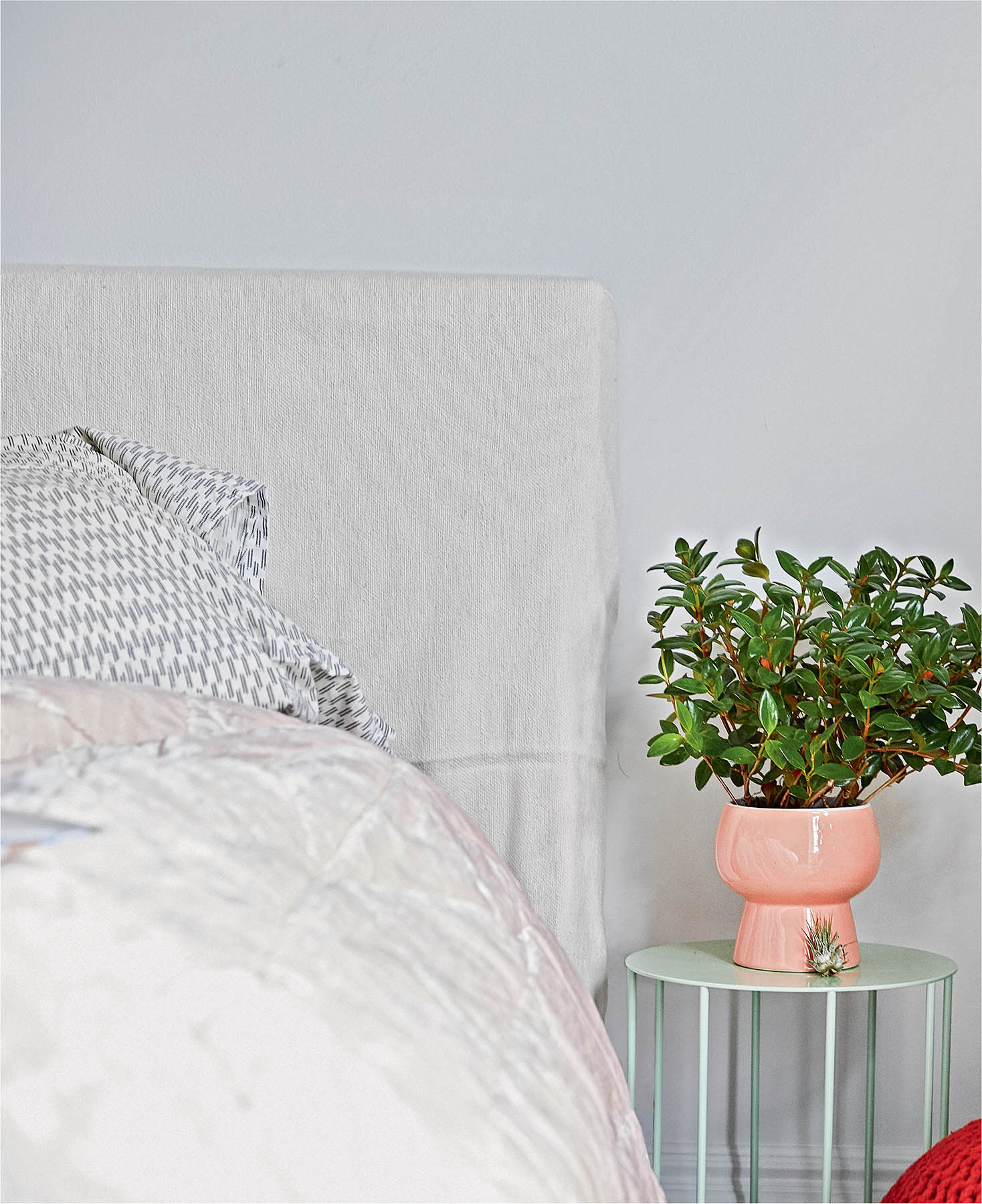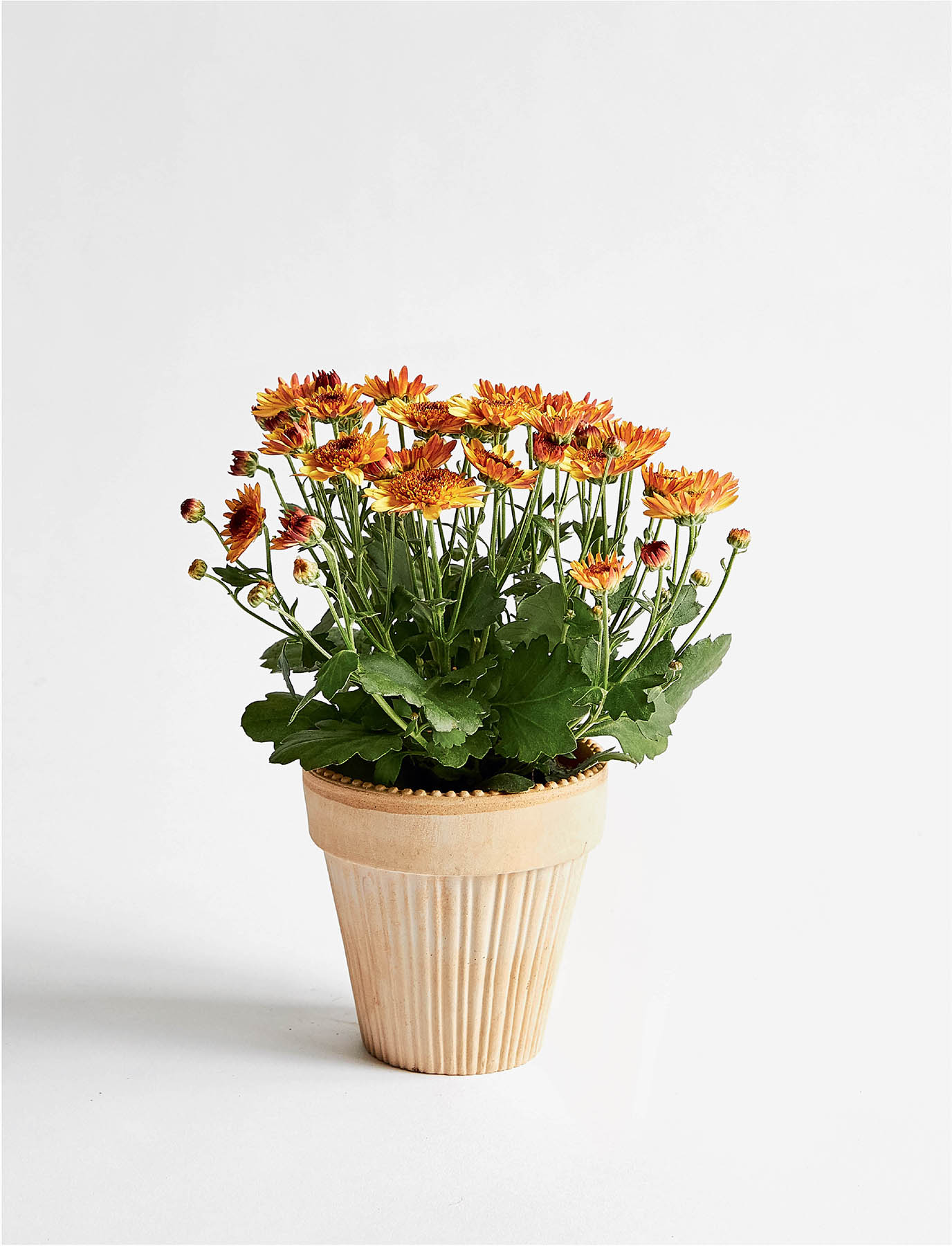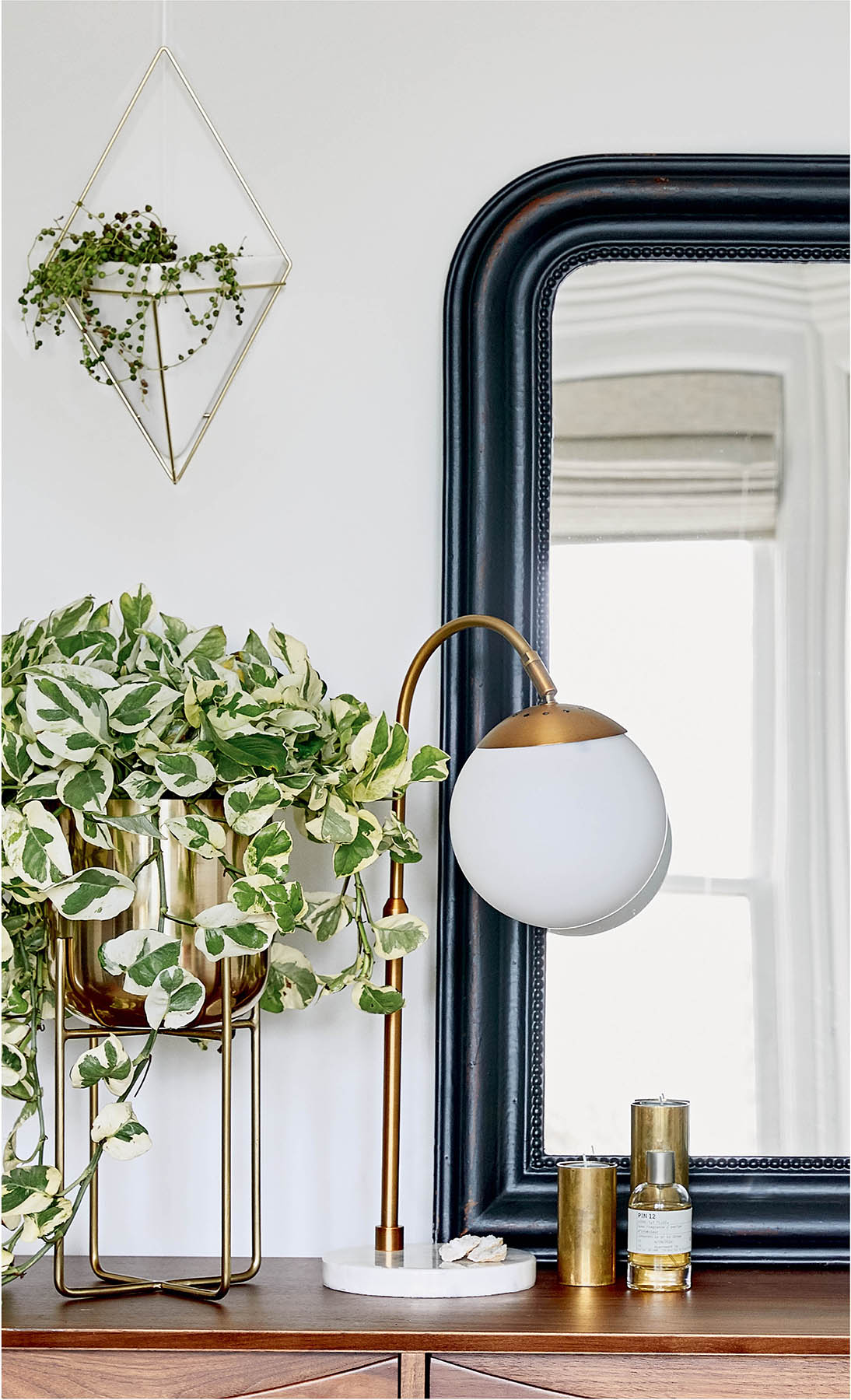

We spend a third of our lives in bed, so our sleeping spaces should be as appealing and comforting as possible. This chapter focuses on the ways plants can help us achieve this. Amazingly, just one plant can make your bedroom air a bit fresher. You’ll also discover plants that help mitigate noise and others that respond to light in a surprising and delightful way. When you’re in bed, it’s lovely to look out on a beautiful array of plants and connect with the calming and restorative effects of nature.
Bedroom Must-Haves
Air Purifiers
Though we all know that plants take in carbon dioxide and release oxygen, they do so much more! Plants fully clean our air, removing the volatile organic compounds (VOCs) found in and released by carpets, cleaning supplies, and paint. In 1989, NASA funded research to discover the best plants for air filtration; it is still considered one of the most comprehensive studies of its kind. Here are just a few of the top contenders.

Snake Plant
The sword-like leaves of the snake plant, or mother-in-law’s tongue, offer up more than a striking architectural presence. Unlike other plants, which release carbon dioxide at night, the snake plant continues to produce oxygen and absorb toxins all night long. Shown here is the ‘Singer’s Silver’ cultivar, which tolerates low light levels and sparse watering; any Sansevieria trifasciata will have a similar air-cleaning effect.

Chrysanthemum
Though temporary bloomers, Chrysanthemum spp., or mums, are an ideal choice for adding a splash of color to the bedroom. Don’t be fooled by their soft facade: these blooming beauties are also a top pick for removing pollutants from the air while you sleep. Keep them in a cool, bright location with consistently moist soil for flowers that last up to six weeks.

Gerbera Daisy
Members of the sunflower family, gerbera daisies (Gerbera × hybrid) offer robust stems, sturdy leaves, and an extensive color palette. Gerberas have proven to be extremely efficient at removing chemical vapors indoors. Keep them in a cool spot with a little morning sun for several weeks of blossoms. Their soil should remain moist to the touch.

English Ivy
An easygoing bedroom companion, English ivy (Hedera helix) is fairly tolerant of low light. The miniature variety ‘Jubilee’ pictured here is but one of many varieties to choose from, all of which can tumble down bedside tables or climb up structures to create a living curtain. They have been proven to reduce allergens and indoor mold counts.
A Jungle Hideaway

This cozy bedroom features more than a dozen plants in a pleasing assortment of forms and textures: airy, upright, sprawling, glossy. The secret to designing a full space like this one, which feels comfortable and intimate rather than crowded and claustrophobic, is to create “zones” within the room and make sure each grouping has a mix of sizes and shapes to mimic what happens in nature. Here are a few more tips.
Take it one step at a time. Let your collection grow slowly. A nightstand topped with an assemblage of plants will offer a wilder, fuller feel than the same few plants scattered around the room.
Aim high. In a real jungle, plants appear at every level, including above your head. So add a floor plant that is reaching for the ceiling (and let it drape slightly, like a canopy over the bed). You can create a similar effect with hanging planters: hang several at different heights to create a living canopy.
Add a focal point. Keep the design interesting yet restful on the eye by opting mostly for simple, soft shapes in a harmonious green color theme. But be sure to incorporate a couple of plants that stand out from the crowd due to their eye-catching color or shape. Thanks to its unusual curved trunk and huge odd-shaped leaves, the snowflake aralia (right) really holds its own, even in a busy crowd.
Clear the way. Once you get bitten by the plant bug, it might be hard to rein yourself in. But remember to keep a path wide enough to negotiate comfortably. This will protect those delicate leafy friends and save you the struggle of navigating an obstacle course each time you cross the room.
Click for a complete list of plants featured in this room.
A Bright and Sunny Space

It’s easy to think of the green of foliage as a “neutral” tone, but don’t forget that it can be employed as a pop of color in your space. This vibrant bedroom balances three equally strong, happy hues: sunny yellow pillows, an azure blue comforter, and the emerald green of the tiny spike moss (left) and tall snake plants (right). The textural art pieces, intricate wooden accents, and patterned pillows are offset by the relative simplicity of the flanking plants.
Plant Palettes
When choosing your next plants, be sure to think about the color of their foliage as well as their size, shape, and care requirements. Green stands in the middle of the color wheel, so it can register to our eye as a warm or a cool color. To “cool down” a hot room, add a gray-green foliaged plant such as a blue star fern. Conversely, a bright neon golden pothos and a cheery pink gerbera daisy will warm up a dim room that needs some oomph!

A Minimalist Oasis
Thanks to the exceptional large bay window, little is needed in this bedroom in the way of decoration. For a clean and calm look, you can’t beat a simple white-and-green palette. Though the vining ‘Jade’ pothos plant opposite adds a bit of color and interest, casting a green hue as sunlight filters through its leaves, consider the planting options below if you’re in search of some privacy.

Screen from Above: To create living curtains, insert a row of hooks along the ceiling and hang plants from them (for a utilitarian look, simply keep your plants in the plastic hanging grow pots they are sold in), or install a shelf just above the window and let full, draping specimens like this creeping ficus hang from it.

Screen from Below: Add privacy from below by lining up a row of tall specimens like these wide-leaved snake plants. If they need a boost, use a box, books, or a plant stand.

Sleep Like a Baby
Plants are nature’s sound machines: they alleviate sound pollution by reflecting, diffracting, and absorbing noise. They can soak up as much sound as a carpet! Here are a few ways to use plants to get a good night’s sleep.
Go big. If you have the space, opt for a floor plant. The foliage of this ‘Limelight’ dracaena (in the foreground) will dampen sound, and so will its large pot and the soil in it. Though the croton (far back corner) is not a tall floor plant, its large leaves are extra-absorbent.
Stick ’em in a corner. Grouping plants together will maximize their soundproofing power. If you place your collection in a corner, noise coming from two different directions will be absorbed—a double whammy for sound reduction.
Create layers. Here, the plants are placed at varying heights: a mistletoe fig “creeps” across the floor with the dracaena and a croton on either side, and a goldfish plant and a tiny Tillandsia ionantha air plant on the table. You could even hang plants from the ceiling to complete the barrier against unwanted sound.

Night Moves
Believe it or not, some plants turn in for the night, too. This sleeping movement, called nyctinasty, occurs in response to darkness. Once the light levels drop, the leaves close up for the night. As the sun rises, you will see the plant “stir” from its slumbering state as its leaves stretch out to collect energy. The sensitive plant pictured here closes at night and also reacts to the slightest touch (a response called seismonasty, a defense against predators), which is why it’s also commonly referred to as the touch-me-not plant. Oxalis and prayer plant are two more movers and shakers; keep these plants near your bedside, and you’ll enjoy the rhythm of the earth’s rotation together.

Open: The sensitive plant likes plenty of direct light, so it’s a lively addition to a sunny room. Allow its soil to dry out a bit in between watering. It’s a slightly fussy houseguest, but when treated right, it is a fast grower; prune it back to keep its mounding habit (as shown here) or it will become tall and lanky.

Closed: This plant doesn’t take more than a second to respond to a poke. Its proper botanical name, Mimosa pudica, aptly warns of this collapse: pudica is Latin for bashful. Once given peace and quiet and some sunlight, it gently opens its leaves once again.
One Dresser, Four Ways
Turn your dresser into a vignette that celebrates your personal style. Choose easy-care plants like the ones featured here to create ambience without adding to your busy schedule.

1. Urban Bohemian
Introduce a laid-back feel by softening bold features, like this large mirror, with a vine or other climbing greenery. Here a grape ivy was attached to the mirror’s frame using clear 3M hooks (which are discreet and removable).

2. Feminine Glamour
Combine softly textural plants—like the delicate beading of string of pearls (above) and the voluminous tousles of ‘N’Joy’ pothos (below)—with statement-making metallic accents to create an elegant space perfect for pampering and indulgence.

3. Sleek Contemporary
Monochromatic colors and subtle patterns create layers of interest without being overwhelming. Here, the sophisticated metallic vase mimics the shape of the mirror frame, and the unusual, architectural ‘Ming Thing’ cactus within sparks interest.

4. Natural Beauty
The vibe here is Scandinavia meets Joshua Tree. Both the plant and the accessories are monotone, so varying textures are key to adding interest: the woven basket against the painted ceramic planter and the soft furry leaves of the ‘Chocolate Soldier’ panda plant.
Small Space, Big Impact
Tall, Dark, and Handsome
Trick your eye and create a space that feels big on green but has a small footprint. If you’re tight on space, these strategies will help you squeeze in more plants without taking up valuable real estate.

1. Pack It In
If you want to add a whole lot of plants into a narrow space, fill a slim-line vase with a smorgasbord of sansevierias. The standard snake plant is included here, as well as more interesting varieties of sansevieria with fabulous names such as shark’s fin, bird’s nest, starfish, and ‘Superclone’! Just like a box of assorted chocolates, it’s bound to draw you in and keep you coming back for more.

2. Give It a Boost
Make a small or medium plant pull the weight of a floor plant, but in half the space, with a plant stand. This one is only 7 inches (18 cm) wide and snugly fits a plant’s vase (or one can be set on top with the addition of a plate). Go even taller by choosing a vertical specimen like a snake plant or, if you have a smidgen more room to spare, add a draping plant like this rex begonia vine.

3. Train It
Variegated fatshedera (pictured here) and other climbing vines can get unruly, but tightly prune and secure the vines to a trellis with twist ties or twine (a technique called espaliering) to keep them contained and almost flat against the surface.